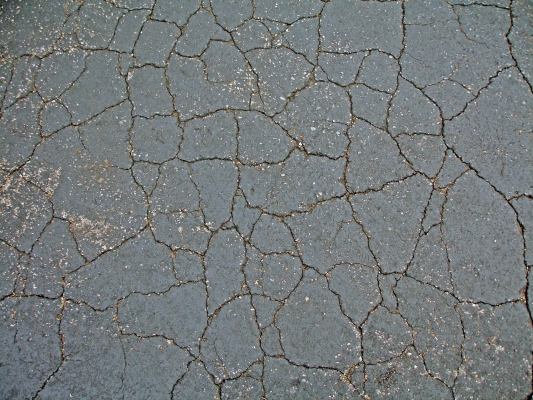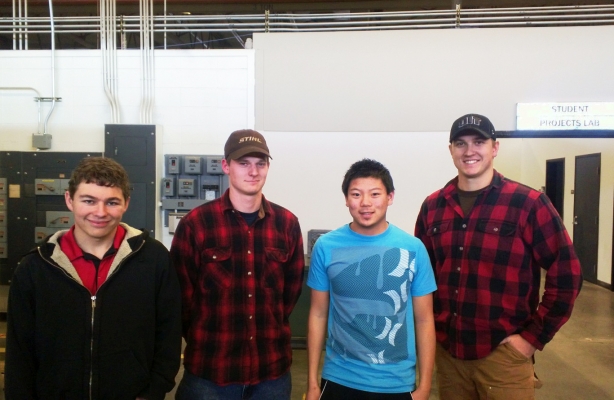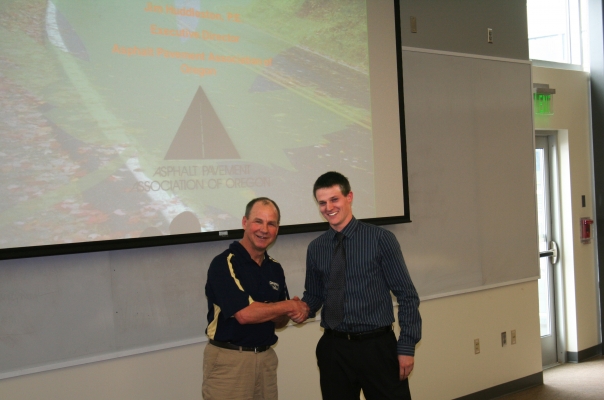Oregon Tech students boosted their knowledge of sustainable pavement on a conference field trip and brought what they learned back to fellow engineering students on their Klamath Falls campus. Students Jared Jones, Zachary Hudspeth, Michael Eagle and Adam Kershaw attended the Oregon Asphalt Conference in Eugene March 5, sponsored by an OTREC student-support grant. Hudspeth, the ITE Student Chapter president, led the group.
The conference was organized by the Asphalt Pavement Association of Oregon (http://www.apao.org/2013ConfProgram2.htm).
The Oregon Tech students were especially interested in hearing about advances in warm-mix asphalt and RAP (reclaimed asphalt pavement). These two asphalt pavement technologies greatly reduce greenhouse gas emissions compared to traditional asphalt paving.
After returning to campus, the students shared their experiences with students enrolled in Oregon Tech’s Civil Engineering 573 Transportation and Land Development class.
The Oregon Institute of Technology welcomed the head of the Asphalt Pavement Association of Oregon for the Oregon Tech NITC Visiting Scholar Seminar. Jim Huddleston, the association’s executive director, spoke Feb. 21 at Oregon Tech’s Klamath Falls campus.
The seminar drew 45 people, including students, faculty and professionals from local consulting engineering firms.
Huddleston, who holds bachelor’s and master’s degrees in civil engineering from Oregon State University, has more than 20 years’ experience in pavement design, construction and analysis. He is one of the nation’s leading experts on asphalt roadways, including innovative and sustainable applications such as recycled, warm-mix and porous pavements.
On his visit, Huddleston also congratulated Oregon Tech senior Zachary Hudspeth on winning an Asphalt Pavement Association of Oregon scholarship in December. Hudspeth is the president of Oregon Tech’s Institute of Transportation Engineers student chapter.
The seminar and student group are supported by OTREC’s National Institute for Transportation and Communities program.
Tensile strain, or strain from heavy loads, causes pavement to crack. But innovations in pavement design aim to reduce such damage. Currently, the Oregon Department of Transportation (ODOT) is in the process of adopting a new pavement design procedure. This involves examining data from existing pavement to predict how much cracking will likely occur in the new pavement. Analysts have already made predictions about how much tensile strain will occur in the new pavement using a procedure known as layered elastic analysis. Dr. Todd Scholzís project gathered key data in order to assess the validity of these key predictions. Want to learn more? You can download the OTREC report at: https://ppms.trec.pdx.edu/media/project_files/OTREC-RR-10-02.pdf.
PRESENTATION ARCHIVE
OVERVIEW
The eruption of Mt. Mazama approximately 7,700 years ago created what is now known as Crater Lake. This eruption blanketed the Pacific Northwest with volcanic ash. This volcanic ash has been collected from several locations in Southern Oregon near the Oregon Institute of Technology campus. This volcanic ash has been tested and shown to have properties beneficial of a natural pozzolan. This seminar will present the results of a significant laboratory program to determine the natural pozzolanic capabilities of Mt. Mazama volcanic ash. In addition, information will be presented on a field application using the material to create ADA accessible trail surfaces.
KEY LEARNING OUTCOMES
- Attendees will learn the location and natural pozzolanic properties of Mt. Mazama volcanic ash.
- Attendees will learn trail surface requirements for ADA accessibility.
- Attendees will be given information on how to use Mt. Mazama volcanic ash for trail stabilization.
THE RESEARCH
This webinar is based on a study funded by the National Institute for Transportation and...
Read more



